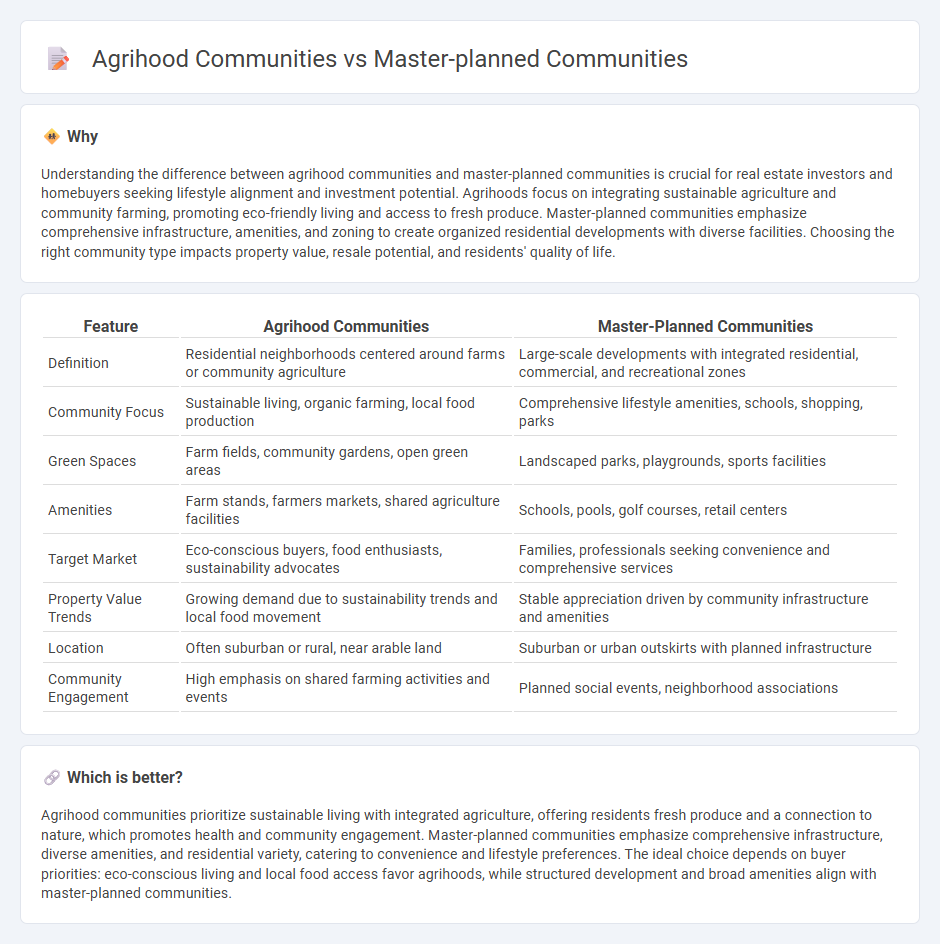
Agrihood communities integrate sustainable farming practices with residential living, offering residents access to fresh, locally grown produce and fostering a strong connection to nature. Master-planned communities focus on comprehensive design, featuring diverse amenities, residential zones, and commercial spaces carefully organized for convenience and lifestyle balance. Explore the unique benefits and considerations of agrihoods versus master-planned communities to determine the ideal living environment.
Why it is important
Understanding the difference between agrihood communities and master-planned communities is crucial for real estate investors and homebuyers seeking lifestyle alignment and investment potential. Agrihoods focus on integrating sustainable agriculture and community farming, promoting eco-friendly living and access to fresh produce. Master-planned communities emphasize comprehensive infrastructure, amenities, and zoning to create organized residential developments with diverse facilities. Choosing the right community type impacts property value, resale potential, and residents' quality of life.
Comparison Table
| Feature | Agrihood Communities | Master-Planned Communities |
|---|---|---|
| Definition | Residential neighborhoods centered around farms or community agriculture | Large-scale developments with integrated residential, commercial, and recreational zones |
| Community Focus | Sustainable living, organic farming, local food production | Comprehensive lifestyle amenities, schools, shopping, parks |
| Green Spaces | Farm fields, community gardens, open green areas | Landscaped parks, playgrounds, sports facilities |
| Amenities | Farm stands, farmers markets, shared agriculture facilities | Schools, pools, golf courses, retail centers |
| Target Market | Eco-conscious buyers, food enthusiasts, sustainability advocates | Families, professionals seeking convenience and comprehensive services |
| Property Value Trends | Growing demand due to sustainability trends and local food movement | Stable appreciation driven by community infrastructure and amenities |
| Location | Often suburban or rural, near arable land | Suburban or urban outskirts with planned infrastructure |
| Community Engagement | High emphasis on shared farming activities and events | Planned social events, neighborhood associations |
Which is better?
Agrihood communities prioritize sustainable living with integrated agriculture, offering residents fresh produce and a connection to nature, which promotes health and community engagement. Master-planned communities emphasize comprehensive infrastructure, diverse amenities, and residential variety, catering to convenience and lifestyle preferences. The ideal choice depends on buyer priorities: eco-conscious living and local food access favor agrihoods, while structured development and broad amenities align with master-planned communities.
Connection
Agrihood communities integrate agriculture into residential neighborhoods, offering sustainable living with access to fresh produce and green spaces, while master-planned communities are designed with comprehensive amenities and infrastructure for cohesive suburban development. Both community types emphasize intentional design to enhance residents' quality of life, combining housing with lifestyle benefits such as recreational areas, schools, and local commerce. Their connection lies in creating self-sufficient, well-organized environments that promote social interaction, environmental sustainability, and long-term property value growth.
Key Terms
Zoning Regulations
Zoning regulations for master-planned communities typically emphasize mixed-use development, integrating residential, commercial, and recreational areas to create self-sustained neighborhoods. Agrihood communities prioritize zoning that supports agricultural activities, such as farmland preservation, community gardens, and sustainable farming practices within residential zones. Explore how these zoning frameworks impact community design and lifestyle by learning more about their regulatory distinctions.
Mixed-Use Development
Master-planned communities integrate residential, commercial, and recreational spaces designed for cohesive living, emphasizing mixed-use development to create vibrant, walkable neighborhoods. Agrihood communities blend sustainable farming with residential living, incorporating shared agricultural spaces that enhance local food sourcing while supporting mixed-use amenities such as markets and community centers. Explore the benefits and unique features of mixed-use development within these innovative community models to understand which suits your lifestyle best.
Sustainable Agriculture
Master-planned communities integrate diverse amenities, infrastructure, and residential spaces with a focus on sustainability, while agrihood communities center around sustainable agriculture by incorporating working farms or community gardens as a core feature. Agrihoods promote local food production, reduce carbon footprints, and enhance biodiversity, making them ideal for environmentally-conscious residents. Explore the benefits of sustainable agriculture in agrihood living to understand its impact on community health and ecology.
Source and External Links
The Top-Selling Master-Planned Communities of 2024 - This list includes the top 50 master-planned communities in 2024, highlighting their features and sales performance.
Best Master Planned Communities for Retirees - This article discusses the benefits of master-planned communities for retirees, focusing on lifestyle, amenities, and community engagement.
Planned Community - A planned community is a settlement carefully planned from its inception, often featuring a comprehensive design and amenities.
 dowidth.com
dowidth.com